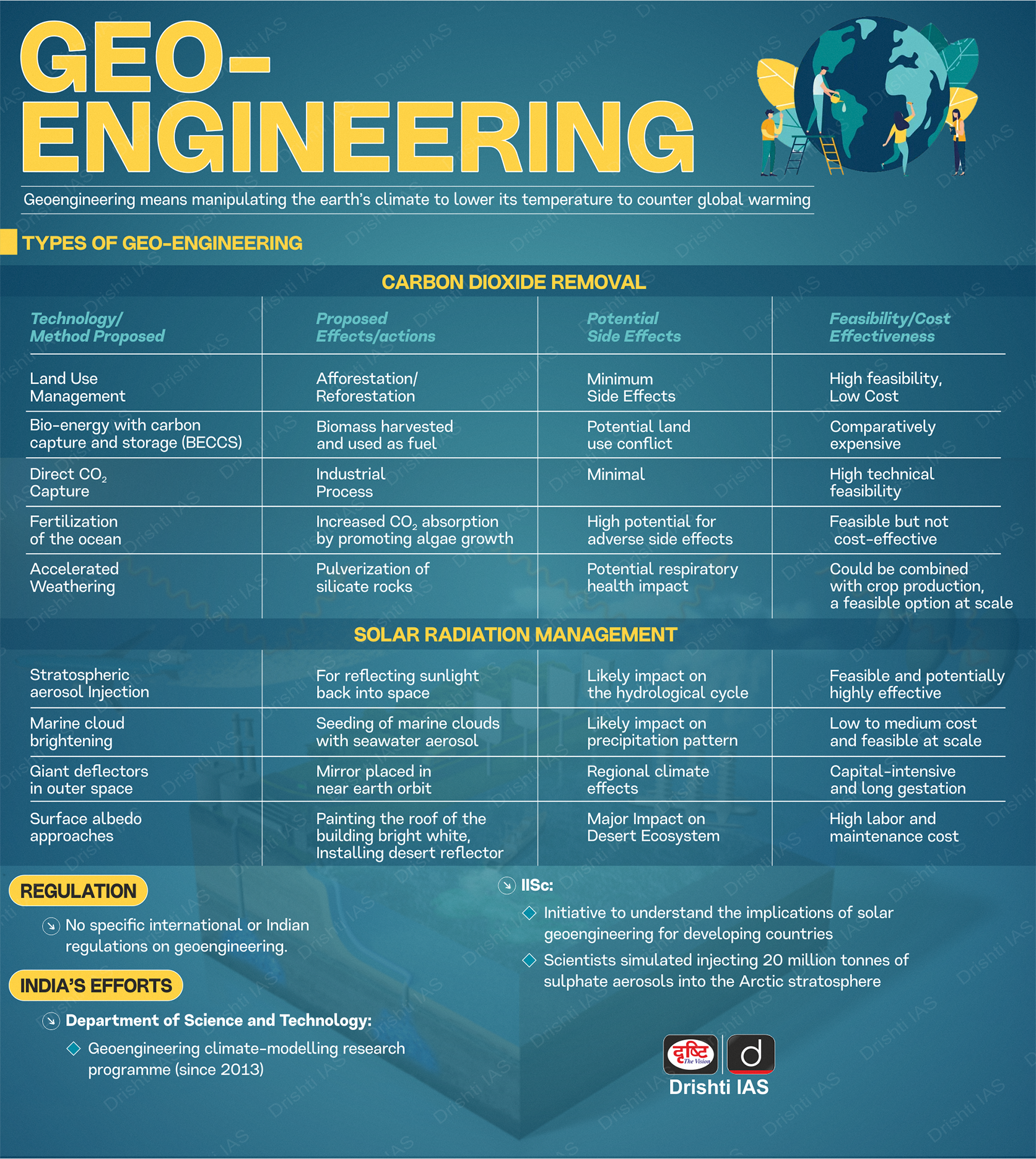Important Facts For Prelims
Geoengineering to Combat Global Warming
- 06 Nov 2024
- 4 min read
Why in News?
A recent study proposes that spraying millions of tonnes of diamond dust annually into the Earth’s upper atmosphere could lower the planet's temperature by 1.6°C, helping to mitigate global warming.
- This geoengineering approach suggests that diamonds could be more effective for Solar Radiation Management (SRM) than materials previously considered.
Current Scenario of Climate Change & Global Warming
- Global temperatures are now approximately 1.2°C above pre-industrial levels (1850–1900) and are projected to reach 1.45°C in 2023, highlighting the urgent need for innovative solutions.
- Current trends suggest that the 1.5°C warming limit established by the 2015 Paris Agreement is unlikely to be achieved.
- Achieving climate targets requires a substantial 43% reduction in emissions from 2019 levels by 2030, though current efforts may yield only a 2% decrease.
What is Geoengineering?
- About:
- It refers to large-scale interventions aimed at altering the Earth's climate system (more specifically solar radiation management) to counteract the effects of global warming.
- Classification: It primarily involves two approaches namely SRM and Carbon Dioxide Removal (CDR).
- SRM: SRM Involves deploying materials in space to reflect solar rays away from the Earth. This method, while still conceptual, draws inspiration from natural phenomena such as volcanic eruptions.
- For example, Mount Pinatubo’s 1991 eruption in the Philippines reportedly reduced Earth’s temperature by 0.5°C that year.
- CDR: Techniques include Carbon Capture and Sequestration (CCS), Direct Air Capture (DAC), and Carbon Capture, Utilisation and Storage (CCUS), with the focus on long-term reduction of atmospheric Carbon dioxide (CO2) levels.
- CCS: It is the main CDR method in practice. It involves capturing CO₂ emissions from industries and storing it underground in suitable geological formations, effectively reducing emissions.
- DAC: It involves extracting CO₂ directly from ambient air using large devices (often called "artificial trees") for storage or use.
- DAC has greater potential benefits as it can address historical CO₂ emissions, though it also faces more significant challenges.
- CCUS: Some captured CO₂ is repurposed in industrial processes, while the remainder is stored.
- SRM: SRM Involves deploying materials in space to reflect solar rays away from the Earth. This method, while still conceptual, draws inspiration from natural phenomena such as volcanic eruptions.
- Related Challenges:
- Implementation Barriers: SRM technologies encounter substantial technological, financial, and ethical challenges.
- Potential unintended effects include disrupted weather patterns, negative impacts on agriculture, and threats to biodiversity.
- Feasibility of CCS: While CCS is presently the most widely implemented geoengineering method, relying solely on it may prove economically impractical compared to shifting toward renewable energy sources.
- Implementation Barriers: SRM technologies encounter substantial technological, financial, and ethical challenges.
UPSC Civil Services Examination, Previous Year Questions (PYQs)
Q1. Which of the following statements is/are correct about the deposits of ‘methane hydrate’? (2019)
- Global warming might trigger the release of methane gas from these deposits.
- Large deposits of ‘methane hydrate’ are found in Arctic Tundra and under the sea floor.
- Methane in atmosphere oxidizes to carbon dioxide after a decade or two.
Select the correct answer using the code given below.
(a) 1 and 2 only
(b) 2 and 3 only
(c) 1 and 3 only
(d) 1, 2 and 3
Ans: (d)
Q. In the context of which of the following do some scientists suggest the use of cirrus cloud thinning technique and the injection of sulphate aerosol into stratosphere? (2019)
(a) Creating the artificial rains in some regions
(b) Reducing the frequency and intensity of tropical cyclones
(c) Reducing the adverse effects of solar wind on the Earth
(d) Reducing the global warming
Ans: (d)







